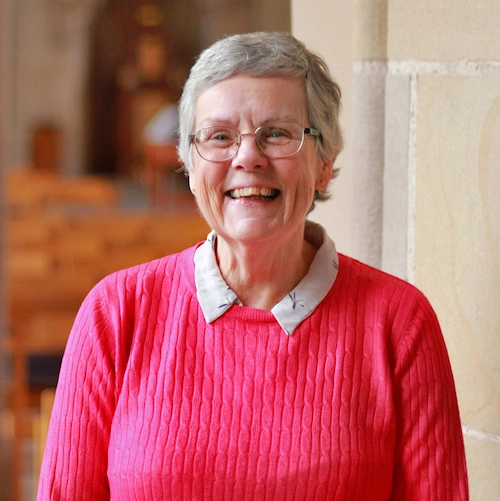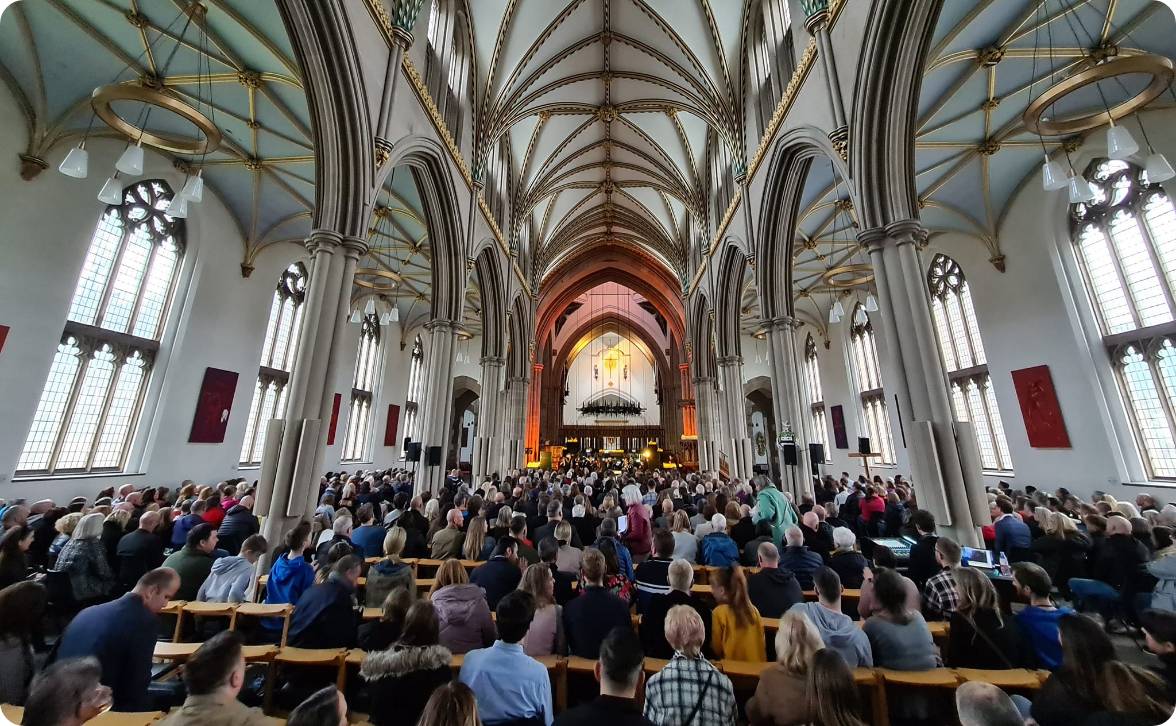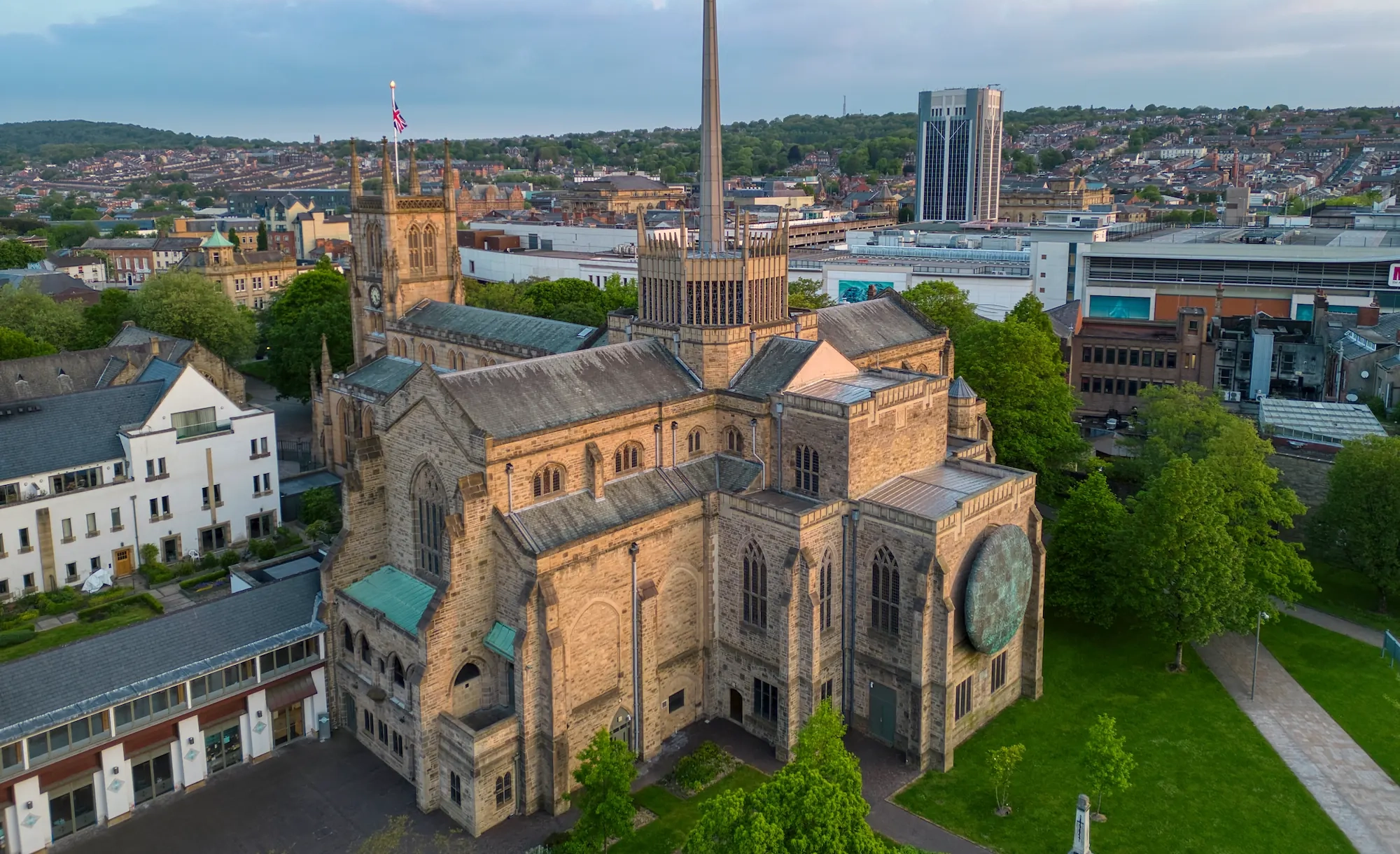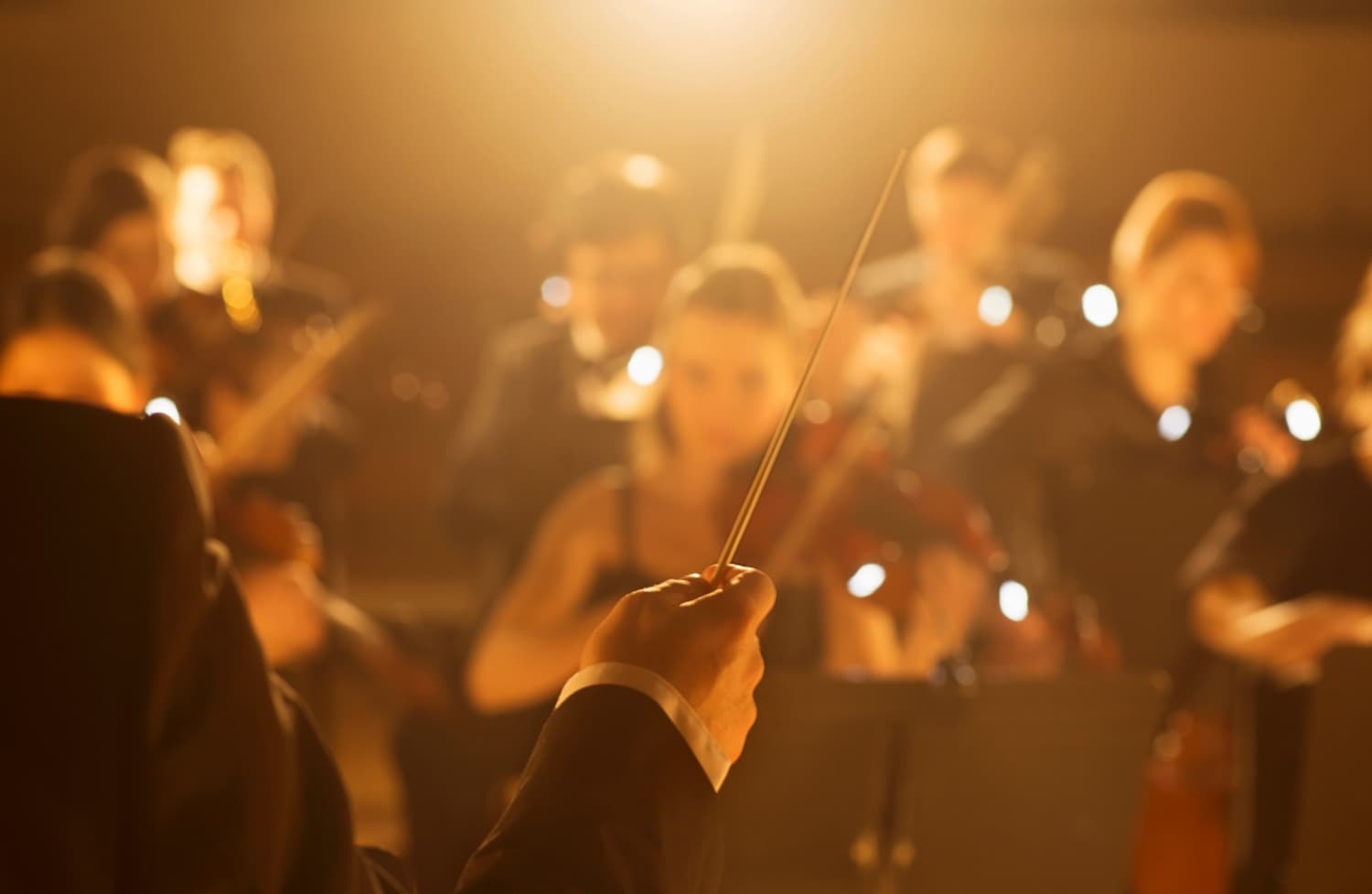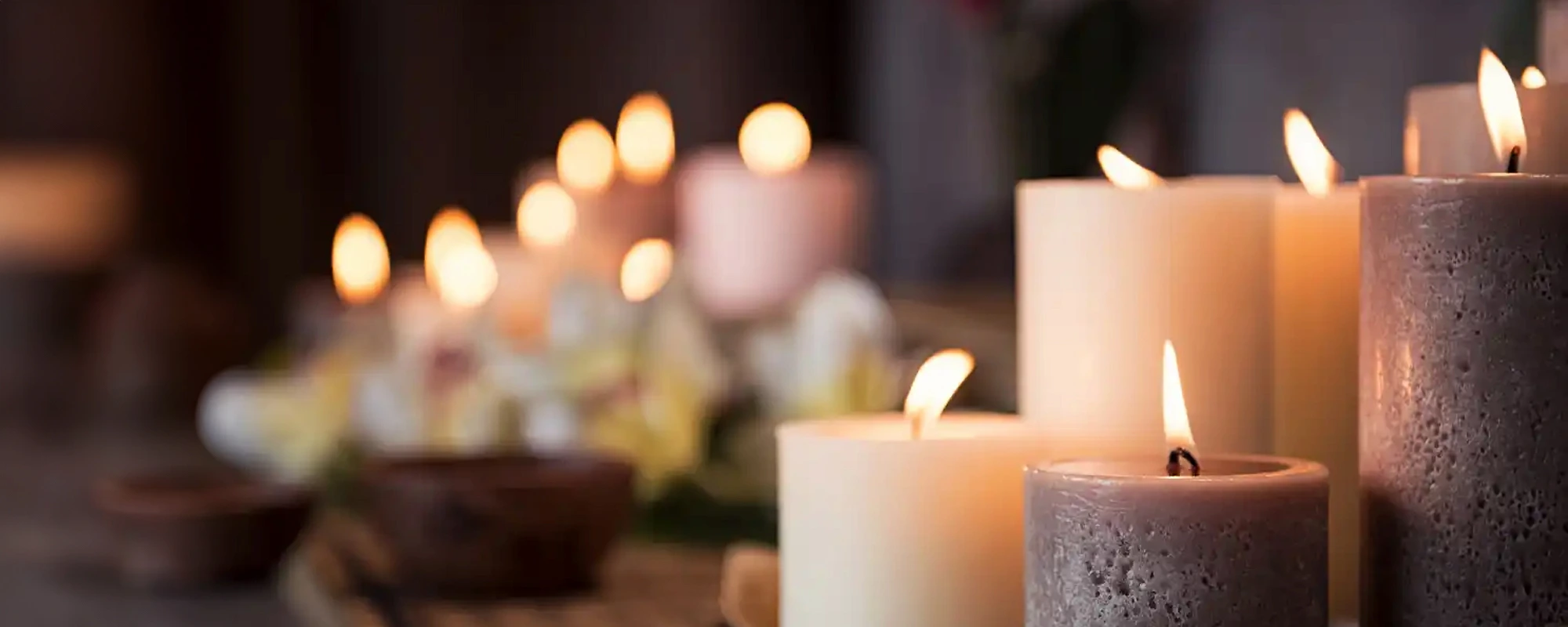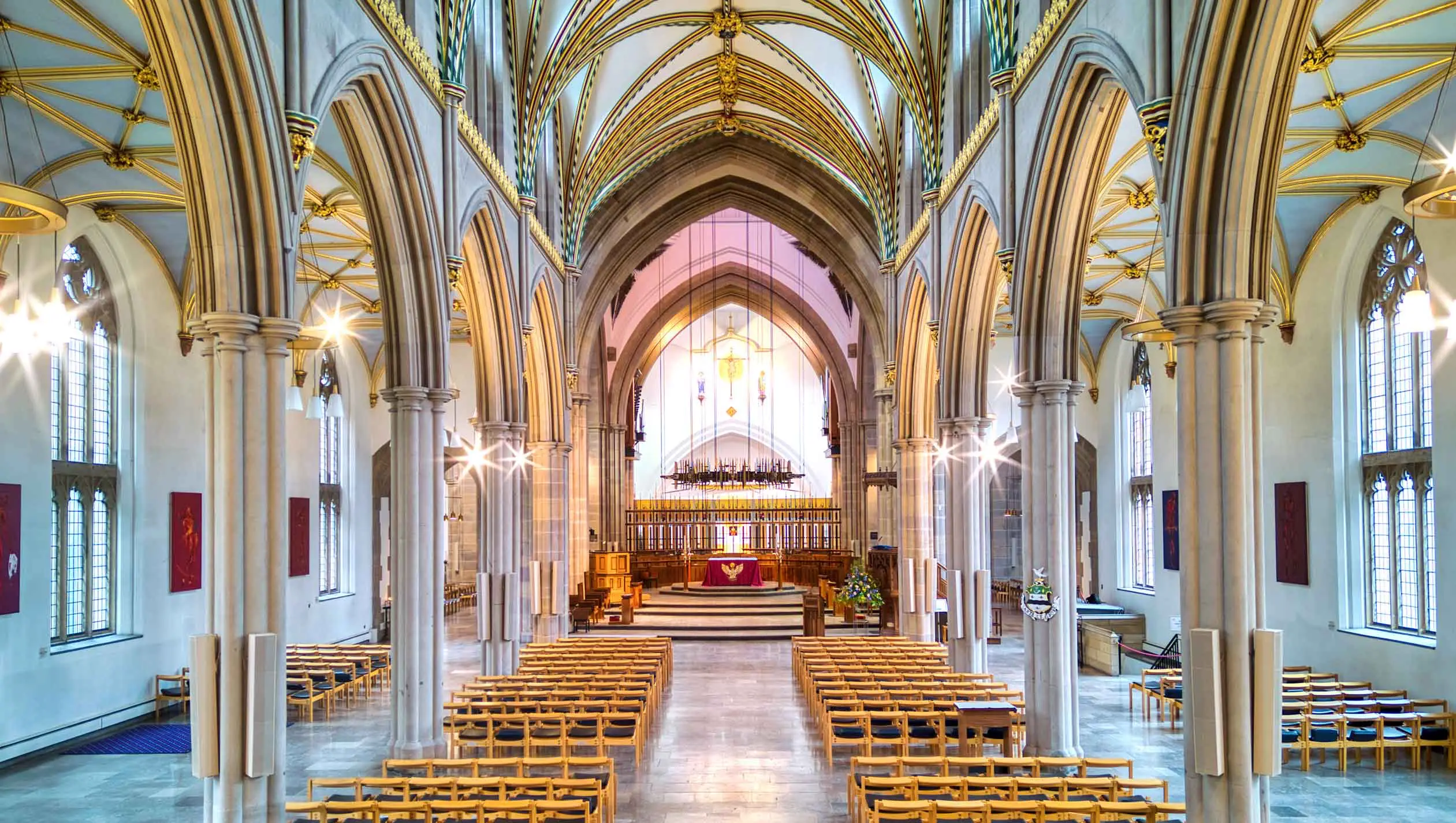
Welcome to the Cathedral Trail
As you explore this incredible building, there are many things to discover. Learn more about the highlights of Blackburn Cathedral.
As you move around the building - you will see signage with a number ① on it that provides an introduction to each highlighted point of interest.
Highlights of the Cathedral Trail to look out for during your visit include:
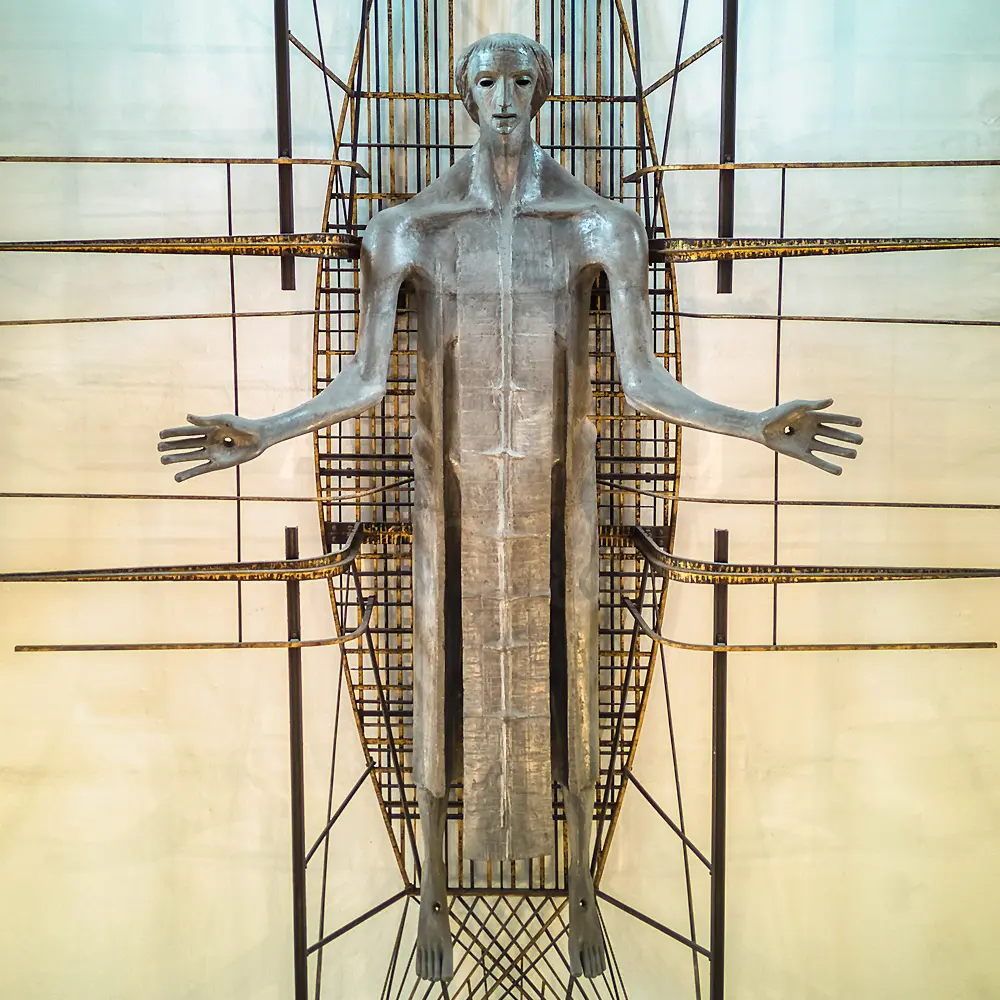
① Christ the Worker
You are now standing in the Nave, the main body of the Cathedral where the congregation sit during worship. The word Nave comes from the Latin Navis meaning ‘Ship’. Before going any further, turn towards the west entrance doors and look up at the imposing statue entitled “Christ the Worker.” This is an ideal way to introduce yourself to the Cathedral, its mission and values.
The artist, John Hayward, has chosen to depict the crucified Christ as a worker: he wears the garment of a manual labourer and the woven boat-like shape behind him suggests and evokes Lancashire’s historic textile industry.
The sculpture reminds us that Jesus lived a life like ours. He shares our sufferings and our joys. Like the first disciples on a lake in Galilee, when the storms of life seem overwhelming, Jesus is in the boat with us.
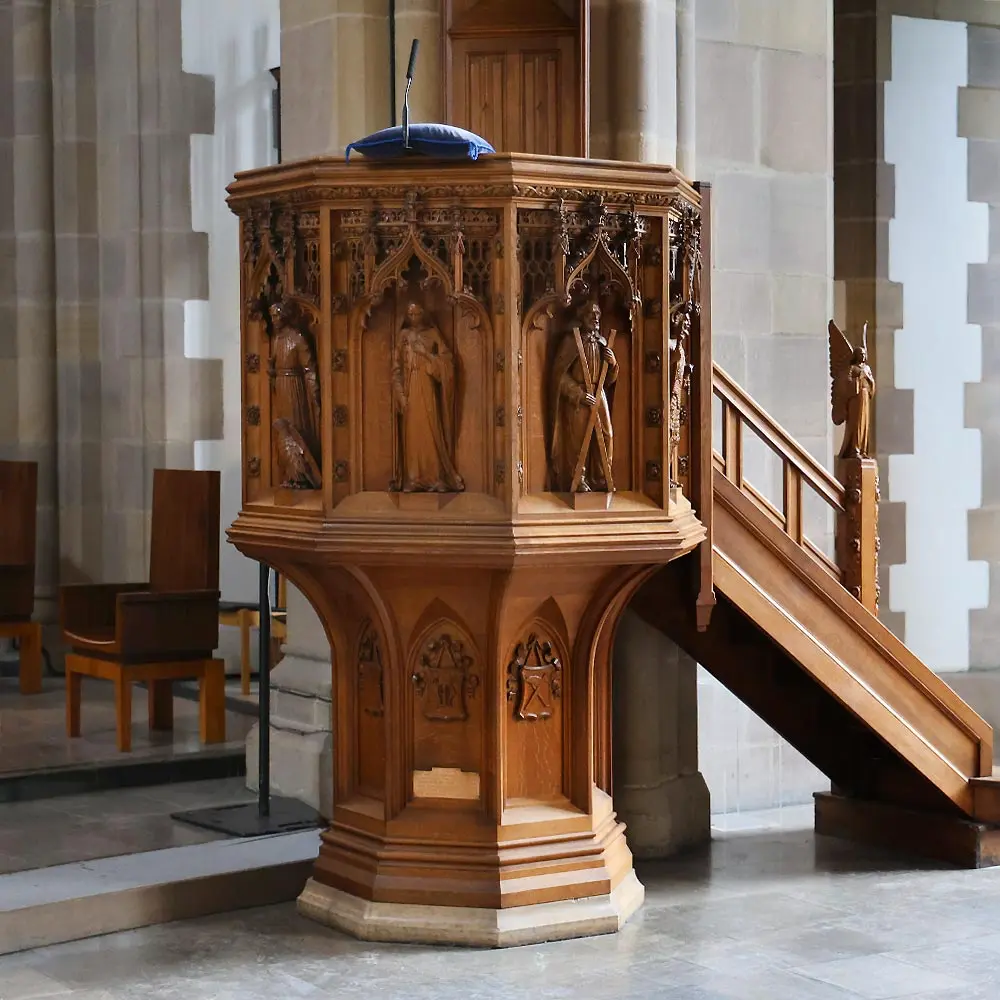
② The Pulpit
The Pulpit is the name given to the raised place from where preaching and teaching take place. This Pulpit was one of the first gifts of 'new’ furniture to mark the transition of Blackburn Parish Church to Blackburn Cathedral. Completed in 1940 as a memorial to local physician Dr. James T. T. Ramsey, it is a particularly fine example of work in the Gothic Revival style. It was designed by W. A. Forsyth and installed into its current position in the 1970s. The six carved figures represent with their emblems (from left to right):
● St. Peter - The keys of the kingdom
● St. James - The shell of pilgrimage
● St. John - The eagle of the Word of God (and the poisoned chalice for an attempt on his life)
● The Blessed Virgin Mary - The rose and the lily of purity
● St. Andrew - The diagonal cross
● St. John The Baptist - The rough clothing and the Lamb of God
On the underside of the pulpit roof (or tester) is the monogram comprising the first three letters (in Greek) of the name JEsUs. Near the top of the back panel is a small 'Braunschweig' cross - a gift from the Lutheran Diocese of Braunschweig (Brunswick) in Germany, with which the Diocese of Blackburn is linked.
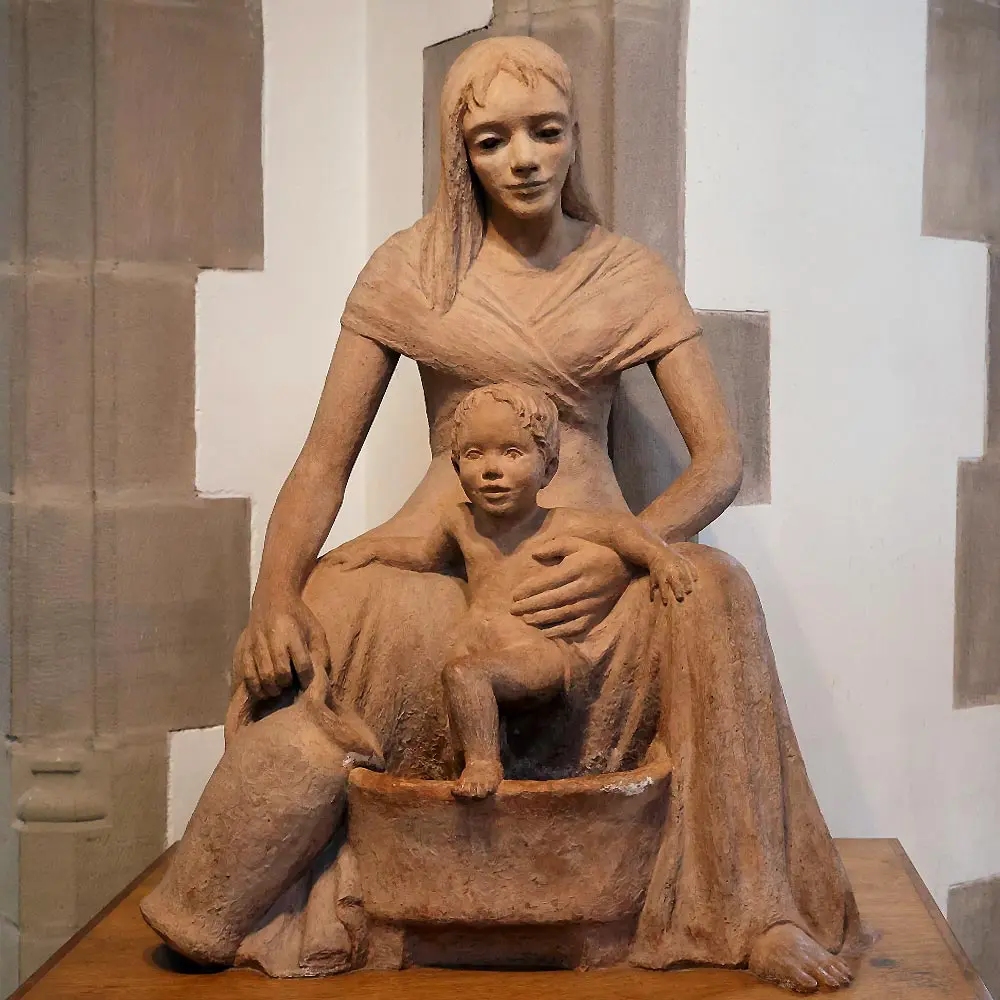
③ Virgin and Child
Blackburn Cathedral was formerly the Parish Church of St. Mary the Virgin. Mary the mother of Jesus is an important person in the account of the Gospel. Josephina de Vasconcellos was commissioned by the Blackburn Diocesan Mothers' Union to sculpt a statue as a memorial to their Secretary, Helen Dex. It depicts Mary the mother of Jesus bathing her son.
Josephina de Vasconcellos is well known for another sculpture, Reconciliation, which is installed in the ruins of Coventry Cathedral and in Hiroshima.
This beautiful and tender sculpture depicts Mary’s love for her son and her willingness to serve him. As she washes the child Jesus, it invokes the joy of her motherhood and the pain that Mary will experience when she watches him die. In response to the news that she would be pregnant with the Saviour of the world, Mary simply responds: “I am the Lord’s servant.” Mary’s willingness to serve is a lesson to all Christians today. Mary was a constant presence in Jesus’ life, there at his birth and at his Crucifixion.
In this sculpture, Mary's hands are holding Jesus back so that his arms are stretched out - as they were to be on the cross. Mary's expression is that of a happy mother and if you view the sculpture from the left you will see a look of adoration. However, if you observe it from the right, you’ll see a look of sorrow, cast in shadow.
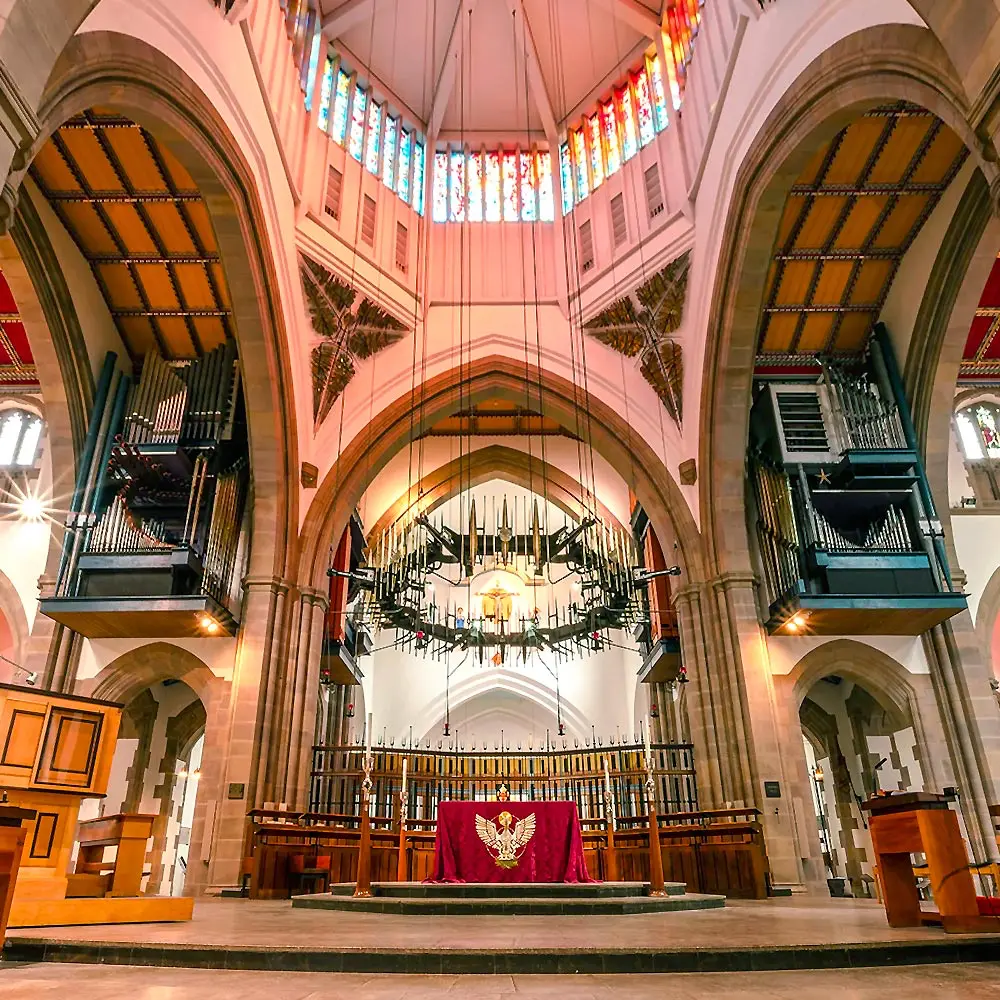
④ The Sanctuary
The Sanctuary is at the heart of the Cathedral where the Table, the place where the Eucharist is celebrated, is located. The architecture draws together all of the elements involved in worship: the clergy, the people, the choir.
Above the Table you’ll notice the Corona, or Crown of Thorns. This dramatic and challenging installation by John Hayward reminds us of the dark heaviness and weight of suffering when Jesus was condemned and crucified. The suspended red lights at the base, represent the drops of blood from Jesus’ crown of thorns. The jewels around the crown, by way of contrast, point to the hope of Jesus’ resurrection from death. For Christians, the crown of thorns is also a crown of glory.
Looking further into the Lantern Tower you will see, in each corner, four six-winged seraphim. These angelic messengers surround God’s throne in heaven crying “Holy, Holy, Holy”.
The last element your eye will be drawn to in the tower is the stained glass. The glass, which was designed by Linda Walton, depicts the water of baptism and the tongues of flame which descended on the heads of the disciples on the day of Pentecost. Throughout the year the sun shines through the glass and illuminates the Cathedral.
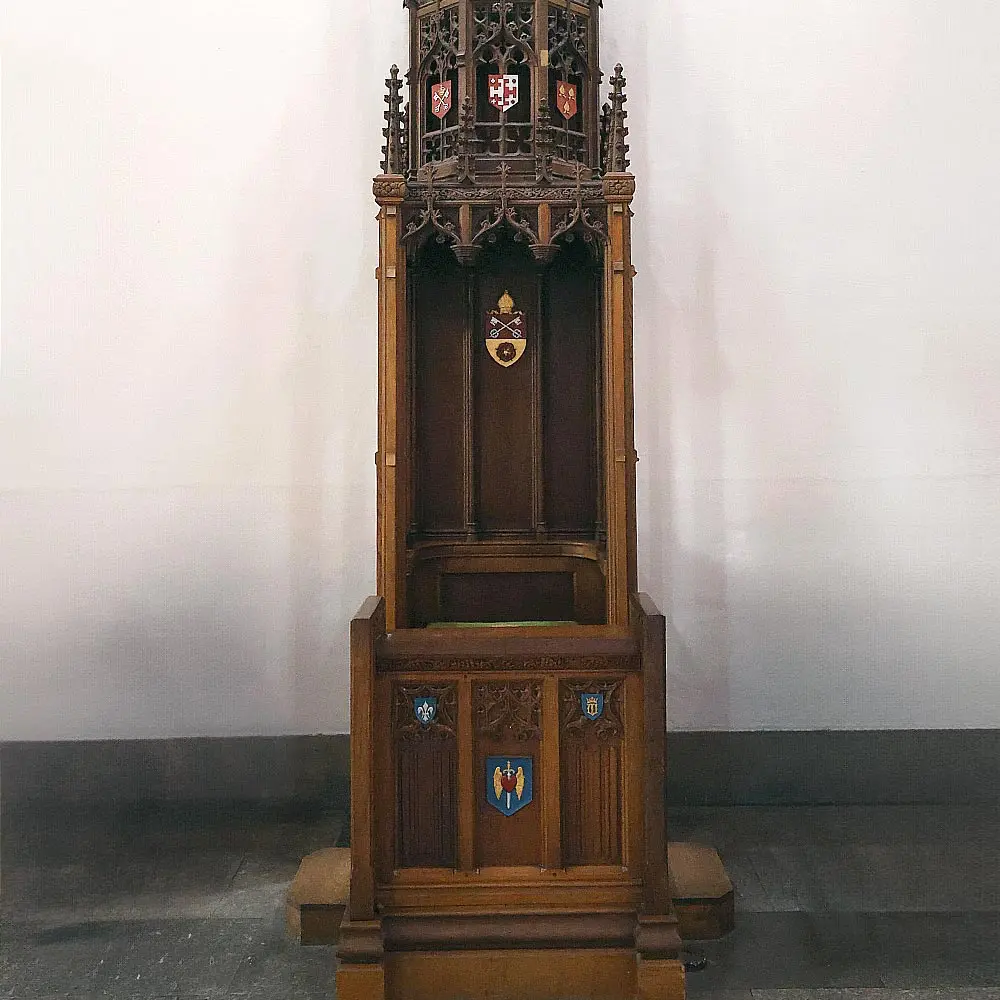
⑤ Cathedra
This building is a Cathedral because it contains a “Cathedra”. Cathedra is a Latin word that means the ‘seat’ of the Bishop.
This Cathedra was carved in memory of Thomas Boys Lewis in 1953 by Advent Hunstone.
It bears the arms of the Cathedral and the Diocese of Blackburn, as well as those of Manchester, Chester and Lichfield.
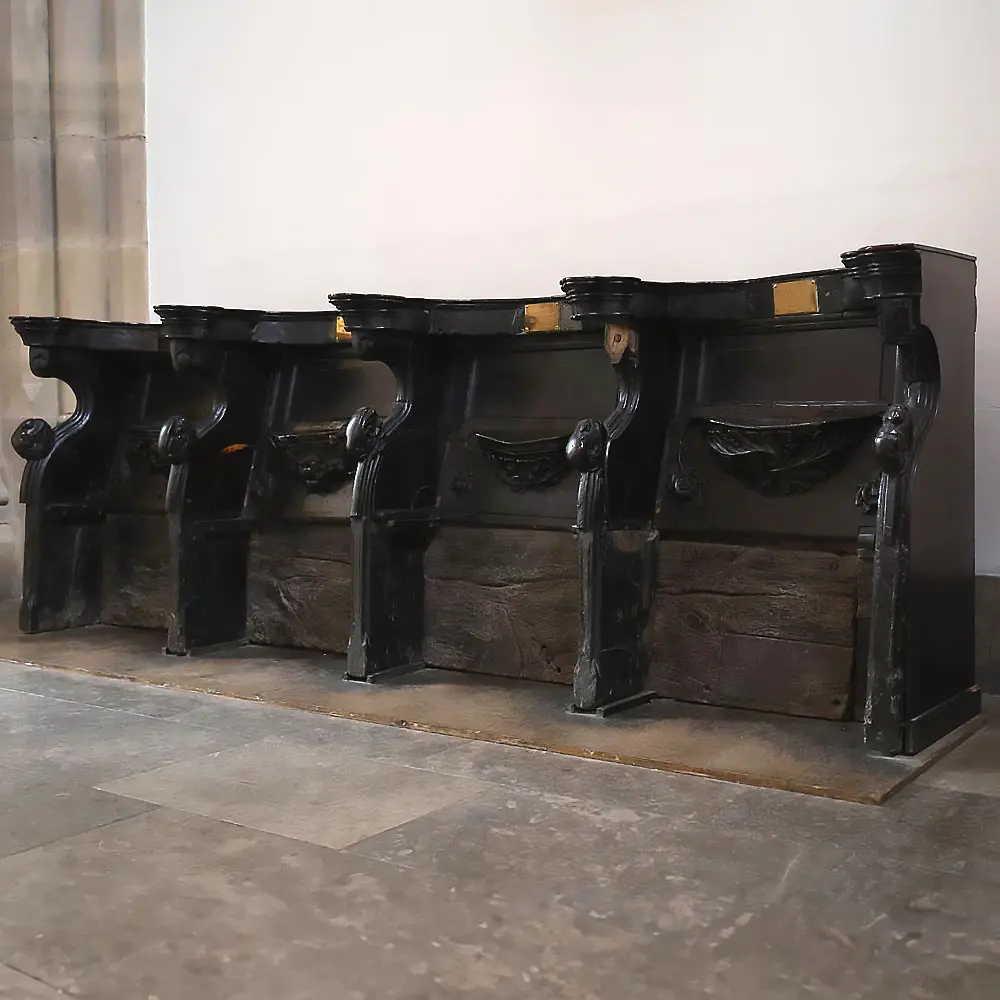
⑥ Misericords
A Misericord, from the Latin word meaning “Mercy Seat”, was a seat used by monks during the night services to rest against so that they could still appear to be standing. These seats were carved from oak in the 15th Century and probably originated in Whalley Abbey or Ribchester Church.
Woodcarvers would often take the opportunity to criticise a person or situation with the carvings under the seat. In these Misericords we can see a fox preaching to geese. This is probably a comment on itinerant preachers who would travel the country pretending to be poor, but were in fact quite well off from all the alms they received. The fox represents hypocrisy and the geese, fools. There are two carvings related to Adam and Eve, separated by The Tree of Knowledge of Good and Evil. A depiction of the Fall and the expulsion from the Garden of Eden. There is an emblem of a Man, representing St. Matthew, a Bull, representing St. Luke and a Lion, representing St. Mark. There are also two lots of foliage and an Ape hunt.
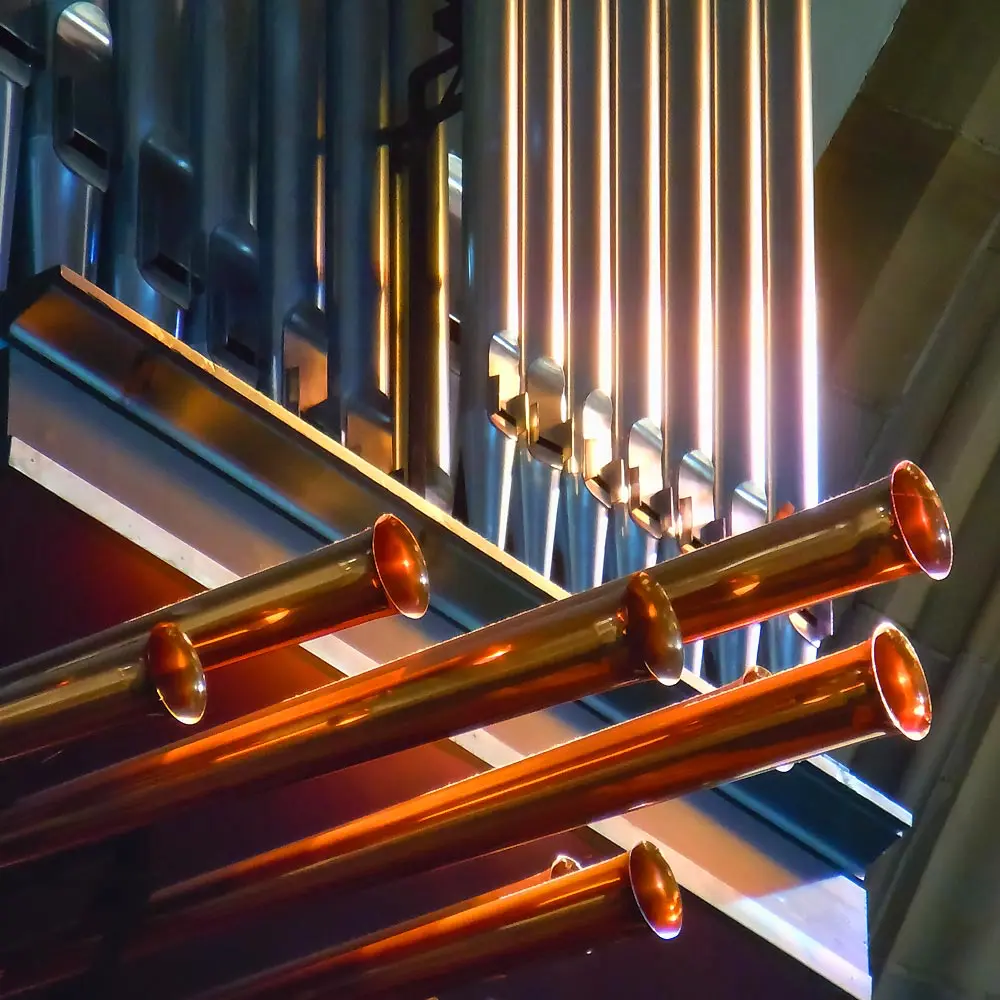
⑦ The Organ
Music is a foundation for Anglican worship and culture in society. Blackburn Cathedral’s organ occupies a special place in advancing the possibilities of sound for liturgical and concert performance.
Built by J. W. Walker and Sons in 1969, the organ uses some metal from the melted-down pipework of the 1875 organ which had previously been on the west wall.
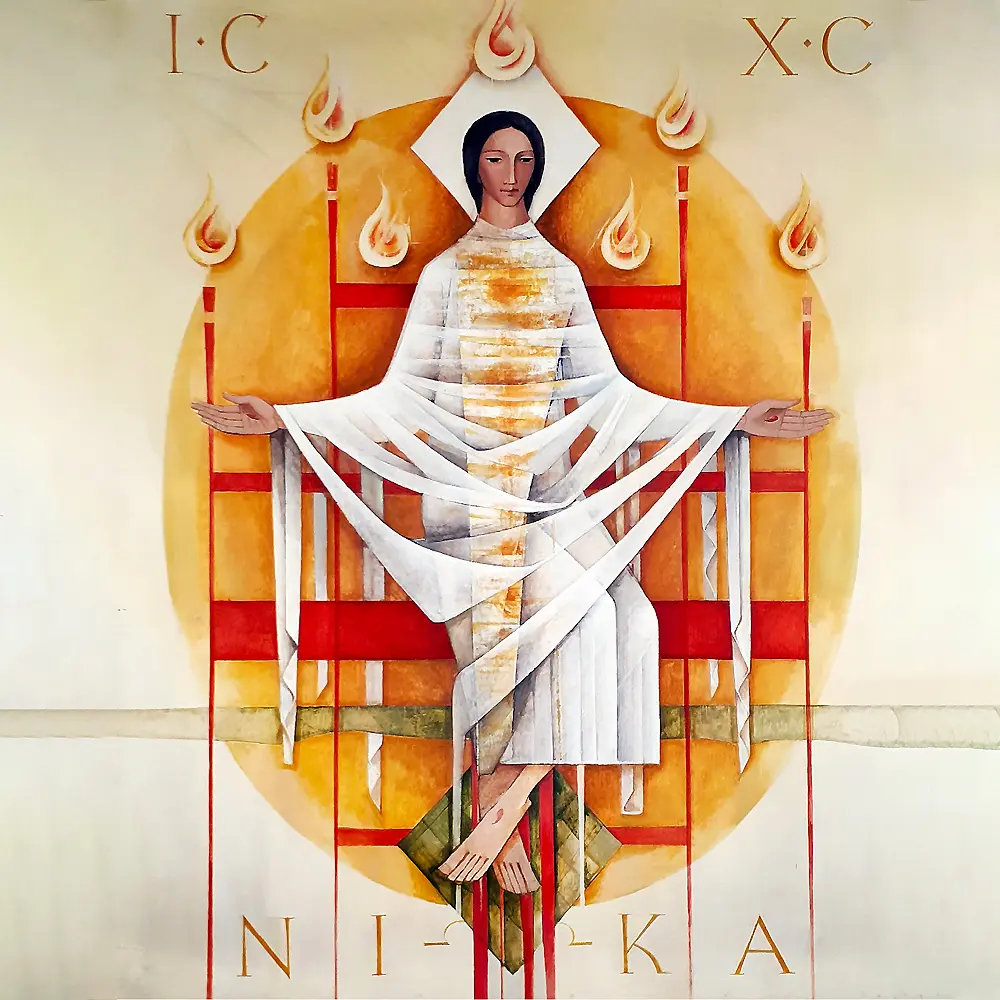
⑧ The Jesus Chapel
The principal work of a Cathedral is to maintain a continuous offering of worship to God. This means that at least twice a day, for every day of the year, the Cathedral meets to pray and worship.
Unlike many cathedrals, where this chapel would be dedicated to the Virgin Mary and be known as “The Lady Chapel,” our chapel is called the Jesus Chapel because the whole Cathedral is dedicated to the Blessed Virgin Mary.
The chapel is dominated by the large icon (which is a special type of religious painting) on the east wall behind the altar. This icon is the work of John Hayward and depicts Jesus’ Resurrection. To emphasise the themes of resurrection and triumph of death, the icon bears the letters IC (Jesus), XC (Christ), NIKA (conquers, or ‘has the victory’).
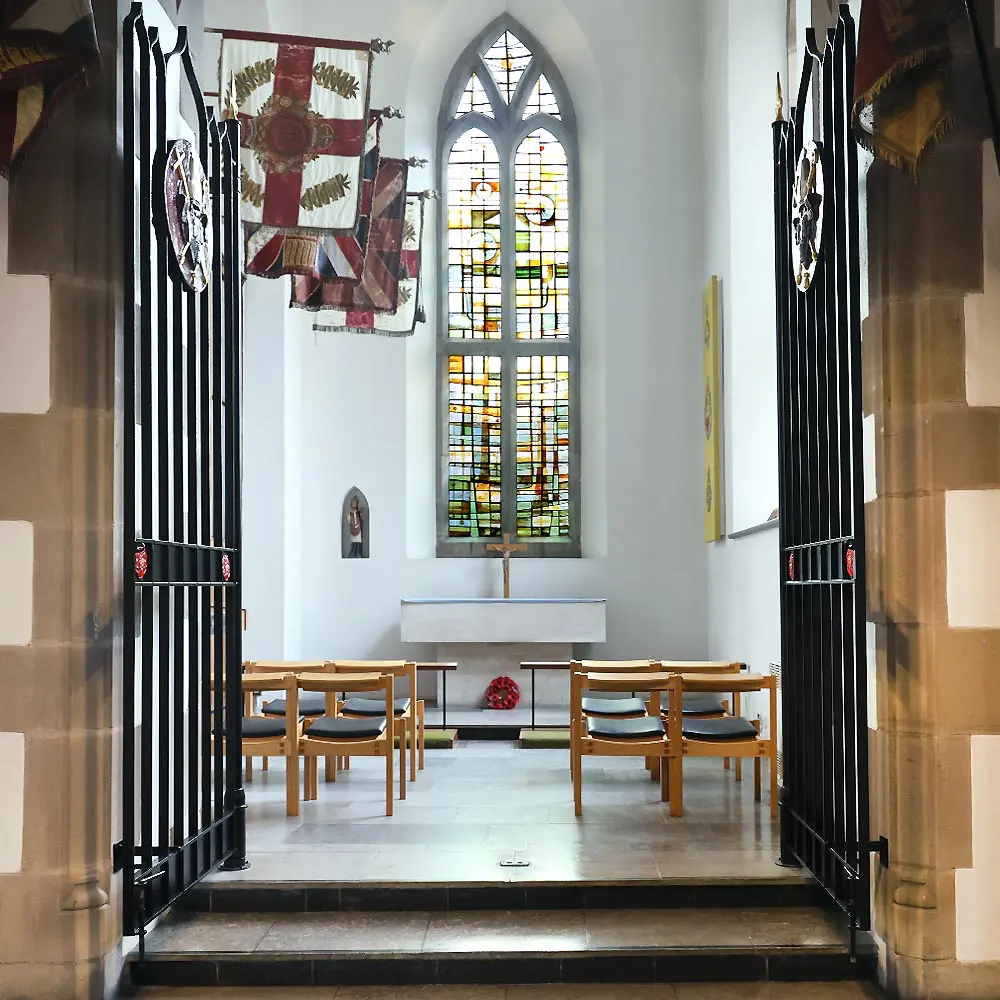
⑨ St. Martin’s Chapel
St Martin was a Roman soldier in the 4th century, who was converted to Christ and became Bishop of Tours in France. This chapel, dedicated in his honour, is the Memorial Chapel of the East Lancashire Regiment, and many of the furnishings were given in memory of individual soldiers. In the far corner is the figure of St Martin, robed as a Bishop, given to the Cathedral by the Church of St Martin in Tours, as a sign of the hope for the unity of all Christian people.
We keep this chapel as a place for private prayer, especially for the peace of the world and the unity of the Church. You are very welcome to enter it to be quiet and to pray.
The stained-glass window was designed by John Hayward and the use of green glass evokes the camouflage of the East Lancashire Regiment. The flags were all carried into battle and hang here as a remembrance to those who died on the battlefield. On the window ledge is a small glass design “Looking for Peace’ by Katherine Monks, commissioned in 2008 for all Asylum Seekers and Refugees in Blackburn with Darwen.
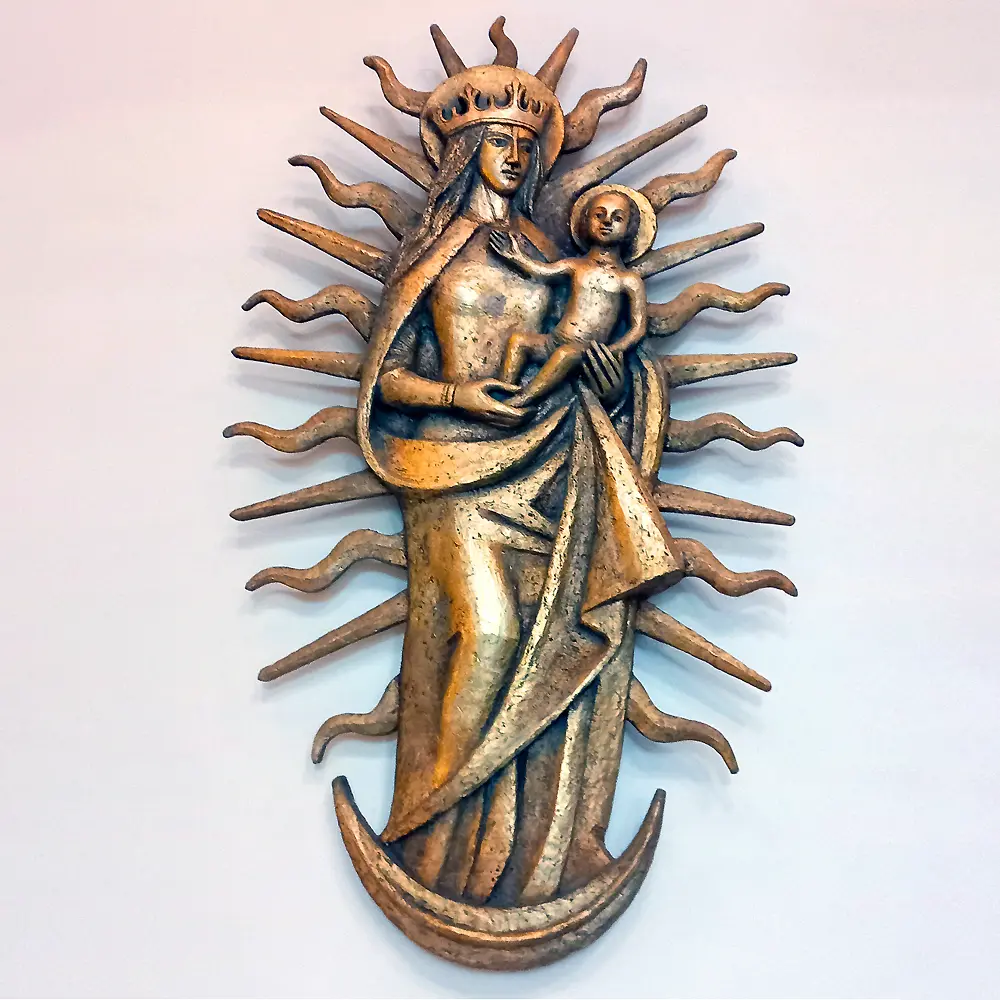
⑩ The Mediaeval Pax
PAX is the Latin word for Peace. The Roman empire was famous for the PAX ROMANA the peace of Rome which was enforced by the war machine of a violent regime. The peace of Jesus, by contrast, is available to all because Jesus took upon himself the violence of the world on the Cross.
Before the Reformation, the Priest and congregation would kiss a PAX during the Peace in the Eucharist liturgy. This handheld liturgical object would be passed around the congregation to kiss before being placed back on the table. At the Reformation, nearly all such items were destroyed as various elements of medieval Catholicism were removed from Protestant Churches.
It is thought that the Blackburn Pax was hidden in the churchyard until it was discovered in 1820, when a tombstone was removed during the building of the new 1826 Parish Church (the nave of the present Cathedral).
On the wall in front of you is a greatly enlarged copy of the rare 15th century Pax in the possession of the Cathedral, the original Pax was 2½ inches high. That Blackburn Cathedral has a medieval Pax is a rare treasure as there are only 13 in the country; one other is held by a Church and all the others are believed to be in private collections.
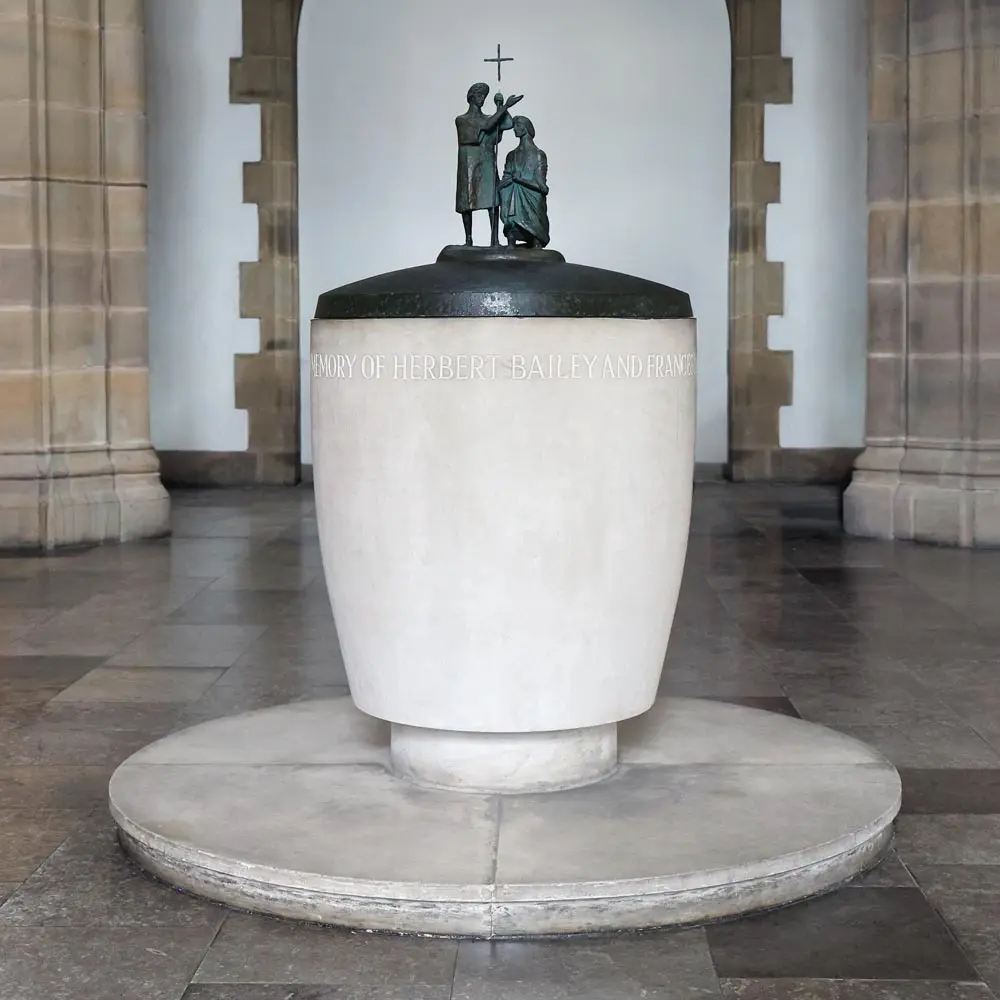
⑪ The Font
It is at the font that Christians are baptised. Baptism is the central act of Christian initiation. Jesus was baptised in the River Jordan by John the Baptist at the start of his ministry. In baptism Christians enter water as they enter into Jesus’ death and come out of the water as they enter into Jesus’ new resurrection life. It is through Baptism that we become members of the world-wide family of the Christian Church.
The font was given by Bishop Charles Claxton (Bishop of Blackburn from 1960 - 1971) and Mrs Claxton in memory of their parents. It is made in the form of an egg, as a symbol of new life, and on its cover is a sculpture of the Baptism of Jesus.
The font is usually located near the west end of a church, often the main entrance to the building and symbolises entry into the Christian faith. When Blackburn’s parish church was redesigned as a cathedral, it was imagined that the South Transept (where you are currently standing) would become the entrance and so the Font was placed here. The final building was never fully realised due to a lack of funds after the Second World War.
The window above the font is made up of fragments of Victorian stained glass window originally at the East end of the Cathedral. There are also fragments of Mediaeval stained glass, believed to be have been saved from windows installed in Norman Church which stood nearer to Darwen Street in what is now the Cathedral grounds. Stand back to see the design, which combines the Cross, the Anchor (symbol of hope) and a Tree (symbol of life) and includes also a blue expanse for the water of Baptism, and many heads watching saints and angels. Other windows both in this area and in the north-east corner of the Cathedral include designs by Burne-Jones, made in the workshop of William Morris.
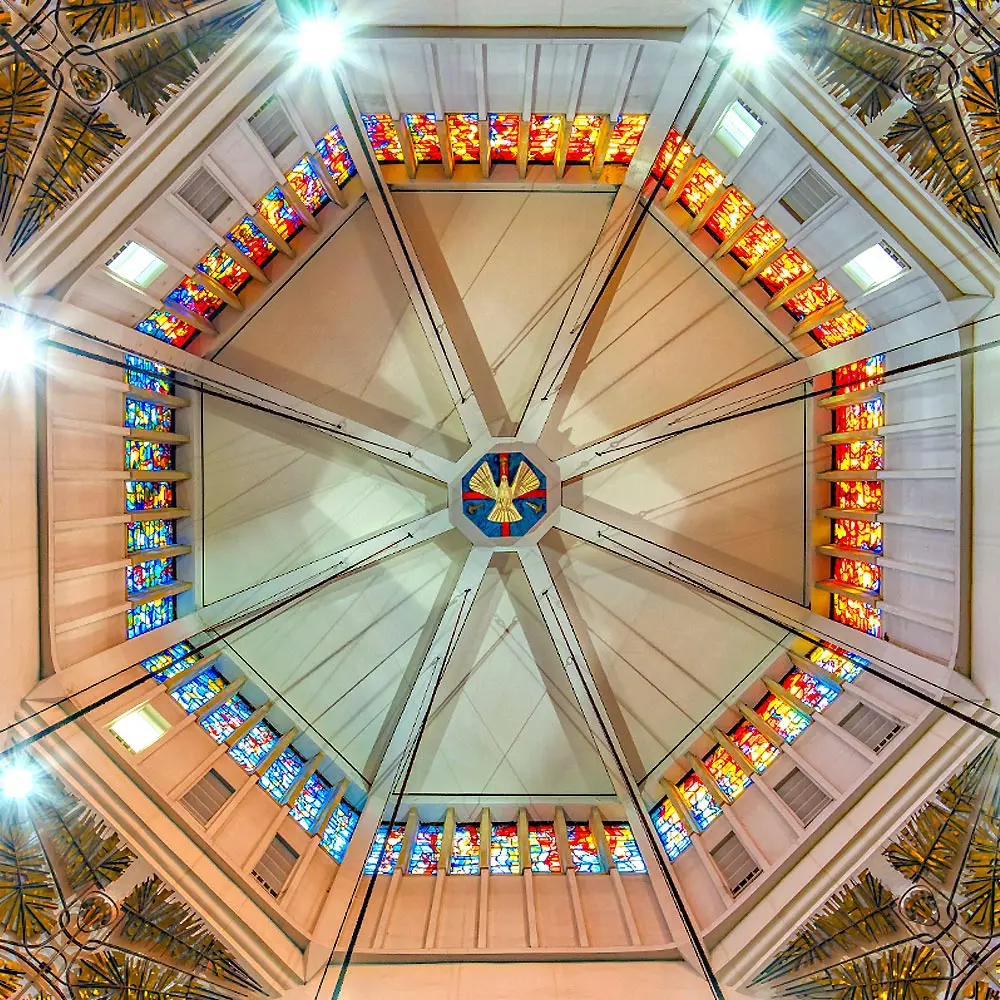
⑫ The Lantern Tower
The Lantern Tower is designed to shine out over the town as a beacon of light and a symbol of hope and trust in God.
At the centre of the interior roof is The Dove - the biblical symbol of the Holy Spirit of God- together with the cross and nails of Crucifixion on Good Friday, which still pierced the hands of Jesus at the Resurrection on Easter Day.
Your visit to Blackburn Cathedral isn’t just about the inside of the building - there’s more to see outside. As you walk around the grounds of the Cathedral, you will find many points of interest, including:
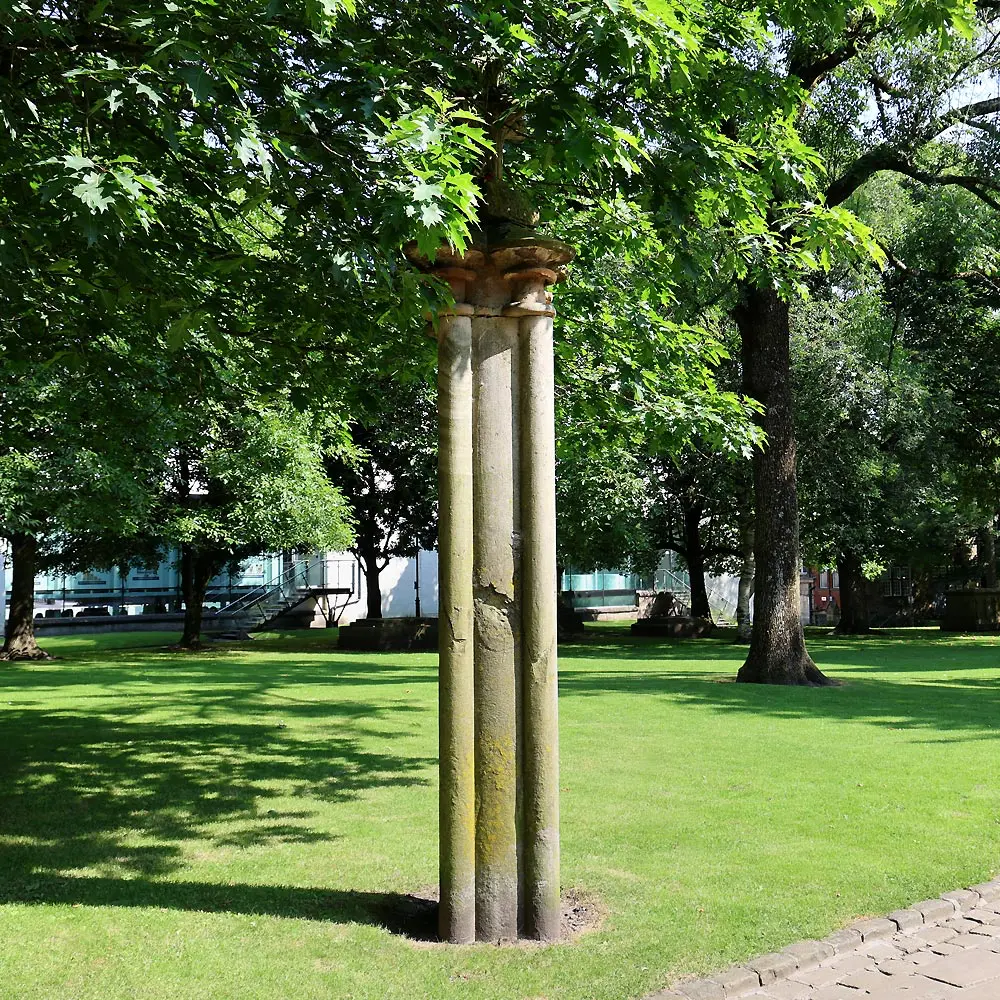
Stone pillar
Facing the Cathedral, on the left hand side by the path is a stone column. This is from the Norman Church and was saved when the Parish Church was demolished in 1820.
It was originally placed near to the gates on the corner of Church Street and Darwen Street as a memorial to all those buried in the early graveyard. It was later moved to its present position and a memorial plaque was put in its place.
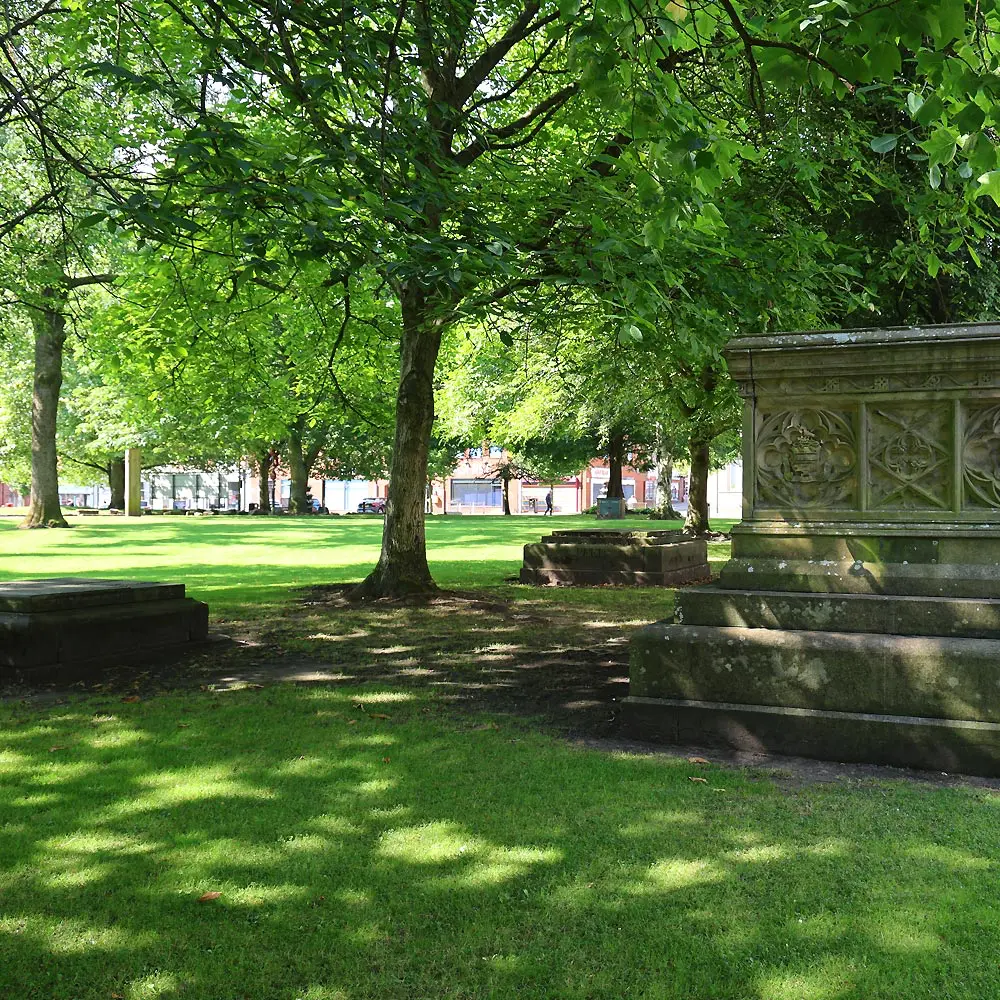
Graves
Also on the left hand side are several graves. These denote the site of the early Parish Churches and there is evidence to suggest that the first Church was built in the 6th Century. These stones mark the graves of several people who were buried under the nave and in the side chapels of the church.
When the church was demolished in 1820 the new church was re sited to the current position of the Cathedral. This meant that these graves would have been exposed so the families were approached to provide suitable gravestones to cover the graves. They include the graves of members of the Feilden and Peel families, notable landowners in the area.
The tomb of the Petrie family marks the site of a Chantry Chapel, founded in 1509 by Lord Derby as a song school and free grammar school for 8 boys. When Chantry Chapels were dissolved during the reign of Elizabeth I she granted the school a charter, it moved to a separate building near to the church and became Queen Elizabeth's Grammar School. It remained on this site until 1826 when it had to move in order to make way for the building of the new Parish Church.
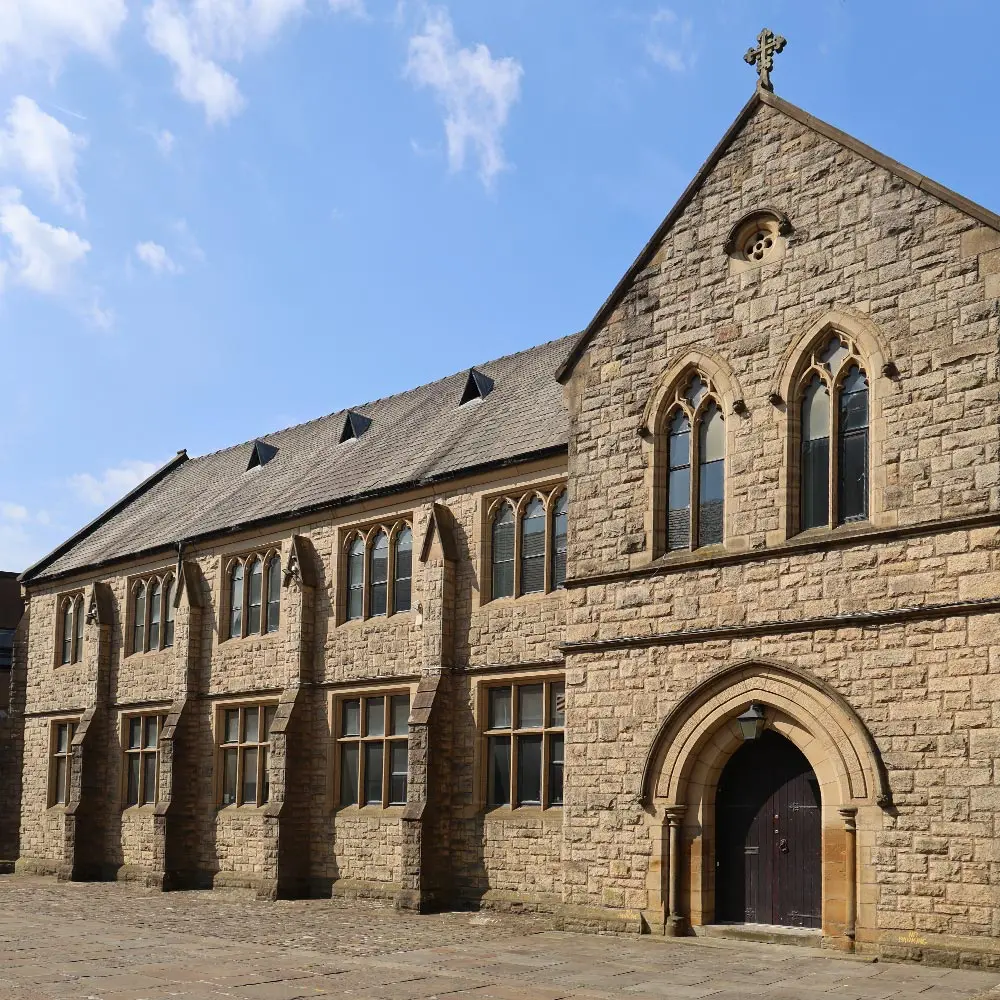
Church House
To the right of the Cathedral, is the only remaining building from the 19th Century - Church House. This housed the Higher Grade School which later became St Wilfrid's Church of England High School.
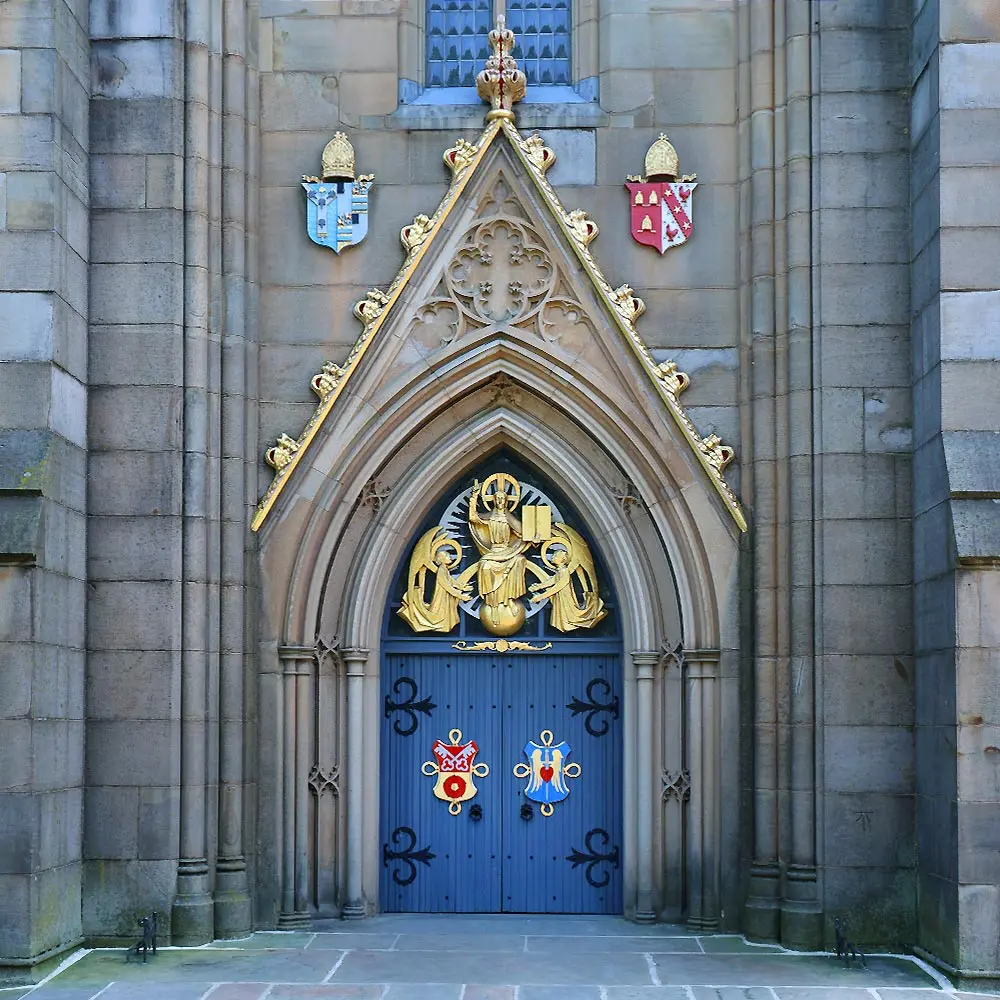
The West Doors
Above the West Doors, the South Porch and North Porch doors are three Tympanum created by Siegfried Pietsch a renowned German woodcarver. At the beginning of the Second World War he was working in England so he was interred and sent to work on a farm for the duration of the war. On his release he chose to stay in England and eventually established studios in St Alban's.
Also above the West Doors are two shields. On the left is the Coat of Arms of the Archbishop of Canterbury who was Patron of the Living 1546-1847 and on the right is the Coat of Arms of the Diocese of Chester, the Parish Church was in this Diocese until 1826 when it became part of the newly created Diocese of Manchester. On the main doors you can find the Coat of Arms of the Diocese of Blackburn created in 1926 and the Cathedral Badges denoting the fact that the Cathedral is dedicated to St Mary the Virgin.
The large oak tree just outside the West Doors was planted in 1936 by the Provost of the Cathedral, the Reverend William Kay .
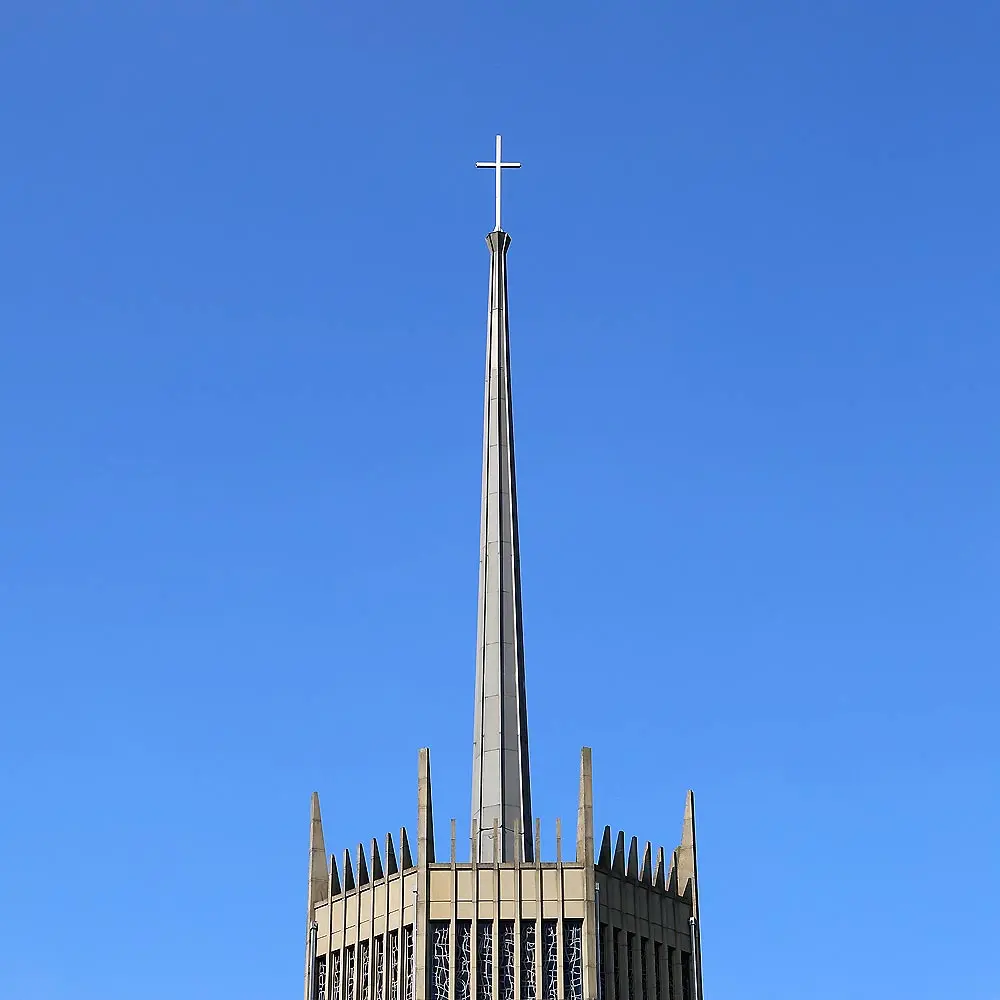
Cathedral Spire
High above the Cathedral is the spire topped by a cross. In 1967 after a blessing by the Bishop the cross was raised to the top of the spire.
In one of the arms of the cross is a capsule containing a parchment bearing the names of everyone holding office in the Cathedral, coins and a copy of the newspaper for that day.
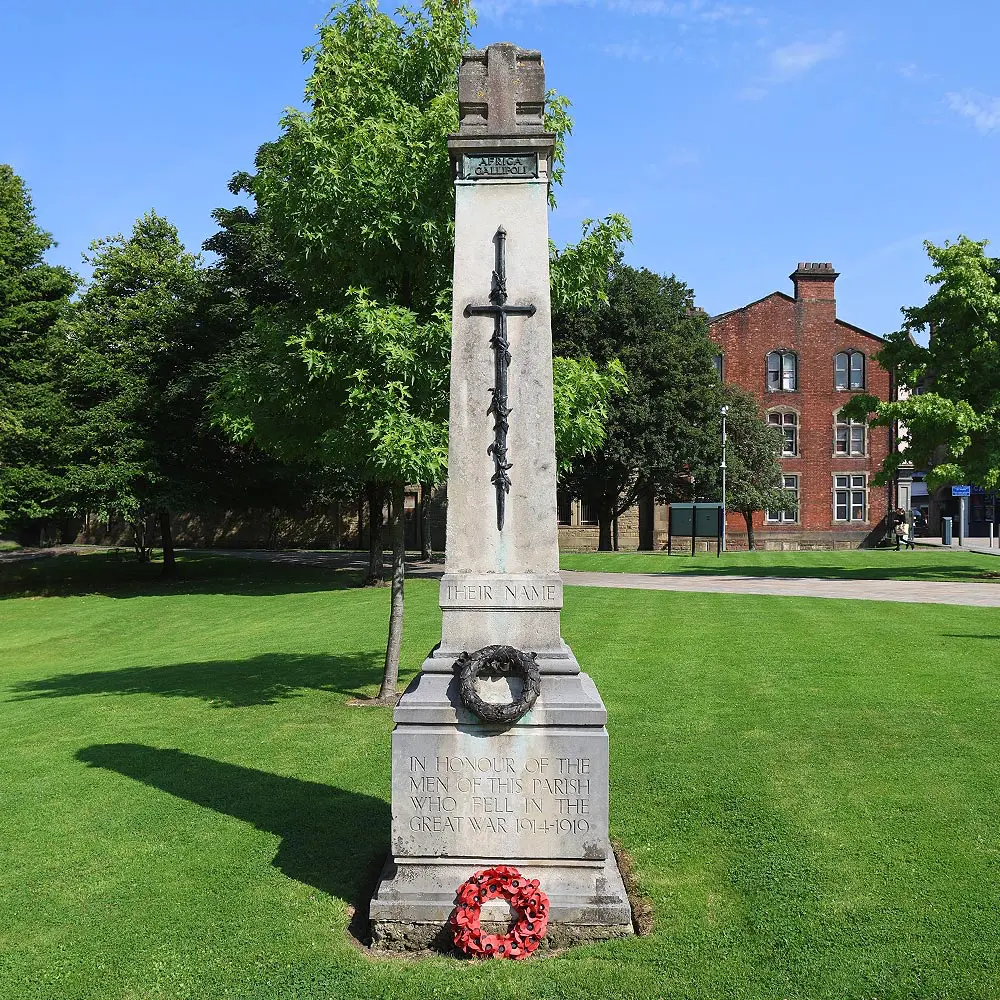
War Memorial
At the back of the Cathedral, looking out on to Cathedral Square, there is a War Memorial. This was originally located in the grounds of St Michael's & All Angels Parish Church in Blackburn. The church was demolished in the 1980s and the memorial was moved to the Cathedral grounds.
It was re-dedicated on 14th November 2015 by Dean Christopher Armstrong. The names of 195 soldiers who died during World War 1 were read out at this service.
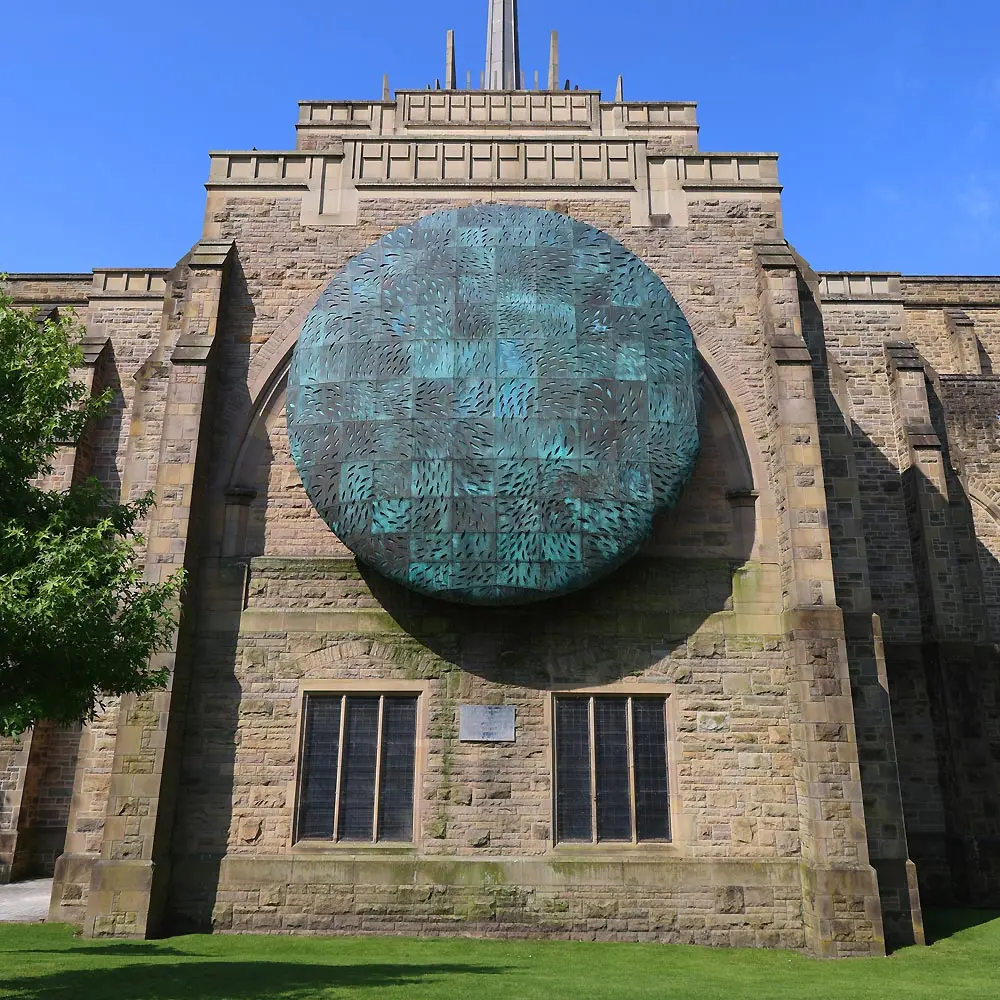
The Healing of the Nations
On the outside wall of the East End is a sculpture created by Mark Jalland to commemorate the new Millennium. Entitled "The Healing Of The Nations" It is a steel and copper globe with a river running through it. The sculpture also depicts the Tree of Life and leaves for the healing of the nations.
This is a reference to the vision of a New Jerusalem described in Revelations 22. The river, tree and leaves are formed of thousands of interwoven fibre optics which create an ever changing pattern when viewed in the dark.
